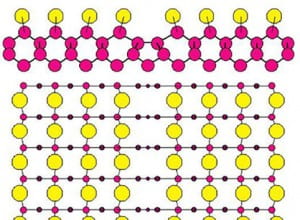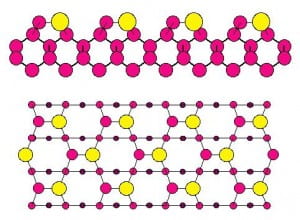Lyman Group
Our research group focuses on structural issues of surface and thin film systems. Principal interests include semiconductor surface structure and thin film growth mechanisms. Our interest in Group IV semiconductor heterosystems is driven by potential electronic applications that can be inexpensively integrated with the dominant material, silicon.
Growth is presently carried out by simple molecular beam epitaxy (MBE). Gas-source MBE capabilities are being added. To determine structure, we use x-ray standing waves, x-ray photoemission, x-ray diffraction, and electron diffraction (LEED and soon RHEED).
Research Interests
-
Semiconductor Surface Structure
- Fig.1 Te/Ge(001)-(1×1) bridge-site structure with missing Te row
- Fig. 2 Streaky Te/Ge(001)-c(2×2) LEED pattern.
- Fig. 3 Te/Ge(001)-c(2×2) heterodimer structure
-
Novel Thin Film Growth
-
X-ray Standing Waves (XSW)
-
High Pressure Surface Science
Using a variety of techniques, my research to date has centered on high-resolution determination of adsorbate structure on semiconductor surfaces, and, in collaboration with the Geochemical Group at Argonne National Lab, adsorbate structure on mineral surfaces.
My most recent work was on the Te/Ge(001) surface, a system that had never been reported in the literature before. Since Te is hexavalent, and the (001) face of Ge has two dangling bonds per surface atom, one would expect that Te would adsorb in a bridge site. In this fashion, 1 ML of Te could completely passivate the surface. However, earlier studies of Te/Si(001) suggested that missing Te rows were formed to relieve the compressive surface strain associated with the large Te atomic radius. This resulted in a streaky (1×1) LEED pattern both in the Si work and in our present Te/Ge(001) pattern. Using x-ray fluorescence, we found that 1.0 +/- 0.1 ML Te adsorbed on Ge(001), and using XSW, we found that the Te occupied the expected bridge site. (See Figure 1).
Upon annealing to 400 deg. C, however, a dramatic rearrangement of The Te atoms took place. The LEED pattern changed to a streaky c(2×2), and about half the Te desorbed. Using a (004) XSW scan, we found that the Te had moved inward by 0.08 Å . Triangulating by using the (022) reflection, we determined that the Te atoms were located in Te-Ge dimers. (See Figure 2) This structure had never before been reported for Group VI/Group IV adsorption. The Te-Ge heterodimers have an average valency of 5, allowing them to satisfy all surface dangling bonds. These results can shed some light on why Te can act as such a particularly effective surfactant in epitaxial growth of Ge/Si(001). (This work has been submitted to PRB.)


